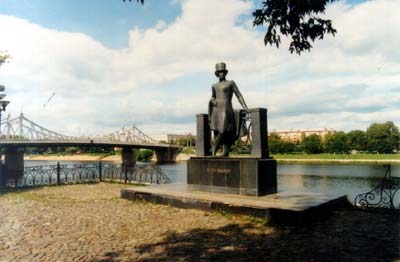Tverskaya Oblast
 Tverskaya Oblast is situated in the central part of the East European plain. It borders upon Smolenskaya, Pskovskaya, Novgorodskaya, Vologodskaya, Yaroslavskaya and Moscovskaya oblasts. The main rivers are the Volga, the Mologa and the Tvertsa. In the territory of the oblast there are more than 500 lakes (including Seliger) and the water basins Ivankovskoye, Uglichskoye, Rybinskoye, Vyshnevolotskoye.
Tverskaya Oblast is situated in the central part of the East European plain. It borders upon Smolenskaya, Pskovskaya, Novgorodskaya, Vologodskaya, Yaroslavskaya and Moscovskaya oblasts. The main rivers are the Volga, the Mologa and the Tvertsa. In the territory of the oblast there are more than 500 lakes (including Seliger) and the water basins Ivankovskoye, Uglichskoye, Rybinskoye, Vyshnevolotskoye.
The climate is moderately continental. The average temperature of January is -9 degrees, of July - +17 degrees centigrade. Precipitations are about 650 mm a year. Coniferous and small-leaved woods occupy about 1/3 of the territory. The oblast was formed on January 29, 1935. Its area is 84,1 thousand sq. km (0,49 % of the total area of the Russian Federation). Distance between Tver and Moscow is 167 km. Tverskaya Oblast includes 36 districts, 23 cities and towns, 4 urban districts, 30 urban settlements, 609 villages. The regional centre is Tver.
The city was founded in 1180. Since 1931 till 1991 it was called Kalinin. The city consists of 5 districts: Zavolzhsky, Moscovsky, Proletarsky, Tsentralny and Ozerny. Other cities and towns are Bezhetsk (1137), Bologoye (1926), Vyshny Volochek (1770), Kashin (1238), Kimry (1917), Konakovo (1937), Nelidovo (1949), Ostashkov (1770), Rzhev (1216), Torzhok (1139), Udomlya (1981). The main cities are Tver (457,9 thousand inhabitants), Rzhev (70,6), Vyshny Volochek (63,8). The population of the region (on January 1, 1998) is 1626,0 thousand people. Density of population (on January 1, 1998) is 19,3 per 1 sq. km.
Tverskaya Oblast is the soul of Russia. It is situated in the northwest region of Russia. The oblast takes the advantageous geographical position at the intersection of the international and internal communications (railways, motorways and waterways) connecting Moscow and Saint Petersburg.
Tverskaya Oblast is a land of forests, rivers and lakes. It is the place where such great rivers as the Volga, the Dnepr and the Northern Dvina and 1500 small rivers more originate from. Since olden days the real natural treasure of the Upper Volga has been the Lake Seliger and all the Valdai lakes where the Volga springs from. The majority of the lakes is connected by channels and rivers, forming the network that are of great importance as a place of rest and tourism. The abundance of reservoirs provides significant fish resources and conditions for boating with license and amateur fishery.
The abundant fauna allows developing the hunting tourism, and the hunt for the wolf and bear is of special interest. Various landscapes allow laying pedestrian, bicycle, automobile and other kinds of routes.
One should visit Tverskaya Oblast to see its historical monuments, architecture, archeology and culture. A part of 300 historical cities of Russia is in the Tverskaya Oblast. They are Tver, Toropets, Staritsa, Torzhok, Kashin, Vyshny Volochek, Bezhetsk, Ostashkov and others.
Tverskaya Oblast is especially rich in monuments of the 18-20th centuries: 14 cities have the status "the monument of town-planning".
The Tver monasteries among which the most ancient are the Boriso-Glebsky (XII c.) and the Otoroch- Uspensky (XIII c.) are of special interest among tourists.
The unique landscape gave rise to extremely beautiful projects. Many places bore the names of "Russian Italy" or "Russian Switzerland". Manors of the Tver land are connected with the names of such outstanding people of Russia as A.S.Pushkin, I.I.Lazhechnikov, L.N. Tolstoy. There is a special route for tourists called 'Pushkin ring of the Upper Volga region' over residential places of the poet.
The ancient history, the advantageous geographical position between two Russian capitals, abundant nature, the developed industry, the intellectual, scientific and cultural potential give hope that the Tver land will attract attention of tourists.
REGIONS OF RUSSIA
Aginsky-Buryat AO I
Altaisky Krai I
Amurskaya Oblast I
Arkhangelskaya Oblast I
Astrakhanskaya Oblast
Belgorodskaya Oblast I
Bryanskaya Oblast I
Chelyabinskaya Oblast I
Chitinskaya Oblast I
Chukotsky AO I
Evenksky AO I
Irkutskaya Oblast I
Ivanovskaya Oblast
Jewish Autonomous Oblast I
Kaliningradskaya Oblast I
Kaluzhskaya Oblast I
Kamchatskaya Oblast I
Kemerovskaya Oblast I
Khabarovsky krai I
Khanty - Mansiysk Autonomous Okrug I
Kirovskaya Oblast I
Komi-Permyatsky AO I
Koryaksky Autonomous Okrug I
Kostromskaya Oblast I
Krasnodarsky Krai I
Krasnoyarsky Krai I
Kurganskaya Oblast I
Kurskaya Oblast I
Leningradskaya Oblast I
Lipetskaya Oblast I
Magadanskaya Oblast I
Moscovskaya Oblast I
Murmanskaya Oblast I
Nenetsky AO I
Nizhegorodskaya Oblast I
Novgorodskaya Oblast I
Novosibirskaya Oblast I
Omskaya Oblast I
Orenburgskaya Oblast I
Orlovskaya Oblast I
Penzenskaya Oblast I
Permskaya Oblast I
Primorsky krai I
Pskovskaya Oblast I
Rostovskaya Oblast I
Ryazanskaya Oblast I
Sakhalinskaya Oblast I
Samarskaya Oblast I
Saratovskaya Oblast I
Smolenskaya Oblast I
Stavropolsky krai I
Sverdlovskaya Oblast I
Taimyrsky AO I
Tambovskaya Oblast I
The Adygea Republic I
The Altai Republic I
The Bashkortostan Republic I
The Buryatia Republic I
The Chechnya Republic I
The Chuvash Rebublic I
The Dagestan Republic I
The Ingushetia Republic I
The Kabardino-Balkaria I
The Kalmykia Republic I
The Karachayevo-Circassian Republic I
The Karelia Republic I
The Khakasia Republic I
The Komi Republic I
The Mari El Republic I
The Mordovian Republic I
The North Ossetia I
The Sakha Republic (Yakutia) I
The Tatarstan Republic I
The Tyva Republic I
The Udmurtia Republic I
Tomskaya Oblast I
Tulskaya Oblast I
Tverskaya Oblast I
Tyumenskaya Oblast I
Ulyanovskaya Oblast I
Ust-Ordynsky Buryatsky AO I
Vladimirskaya Oblast I
Volgogradskaya Oblast I
Vologodskaya Oblast I
Voronezhskaya Oblast I
Yamalo-Nenetsky AO I
Yaroslavskaya Oblast I
[ About Russia ]
[ Listen to the national anthem of Russia ]
[ The State flag ]
[ The State emblem ]
[ Power structure of Russia ]
[ Regions of Russia ]
[ Cities of Russia ]
[ Nations of Russia ]
|